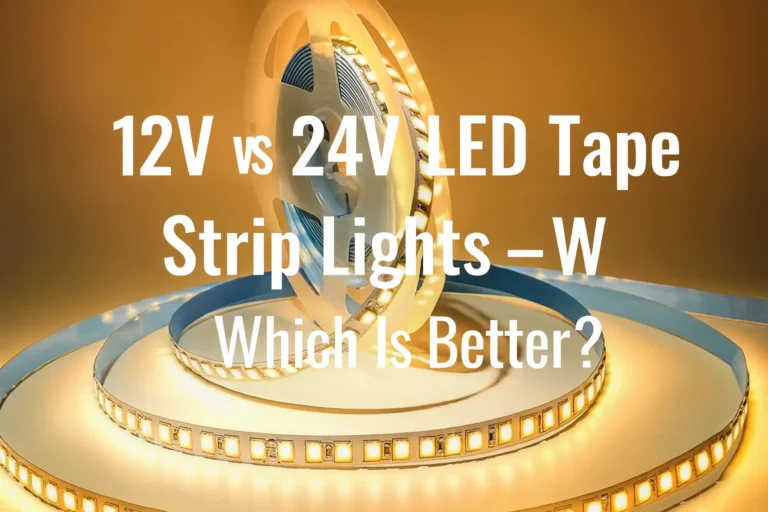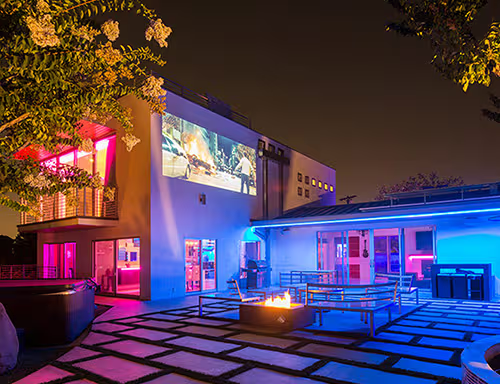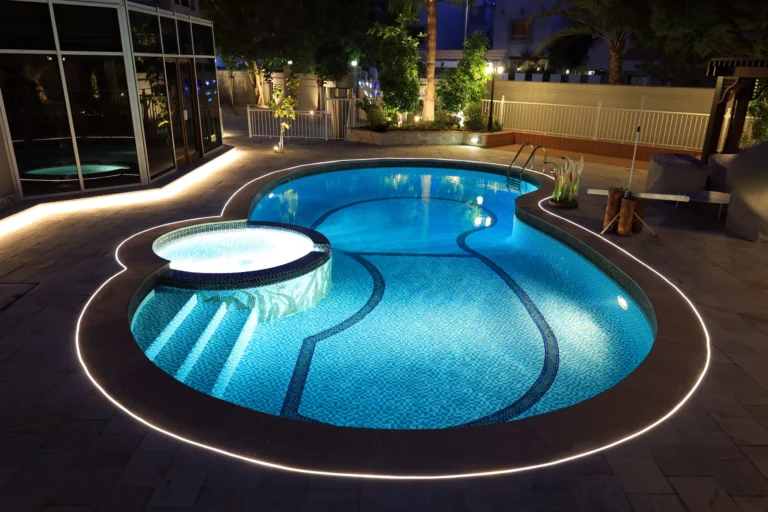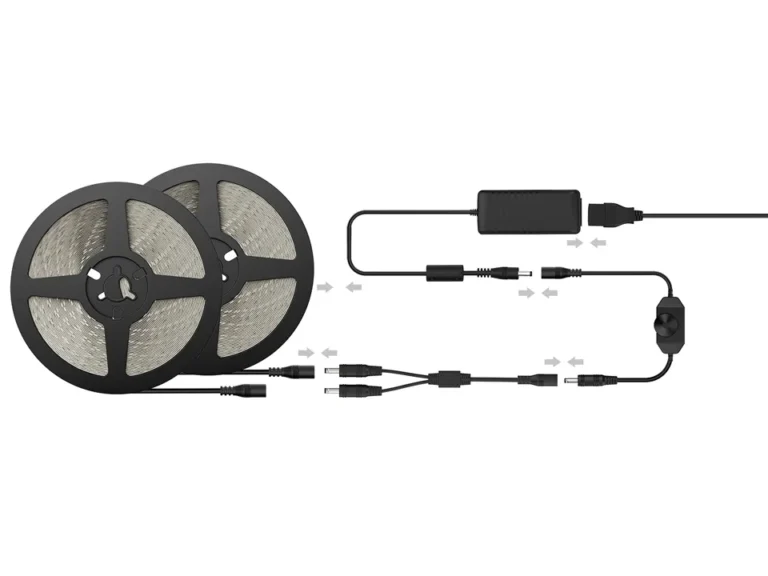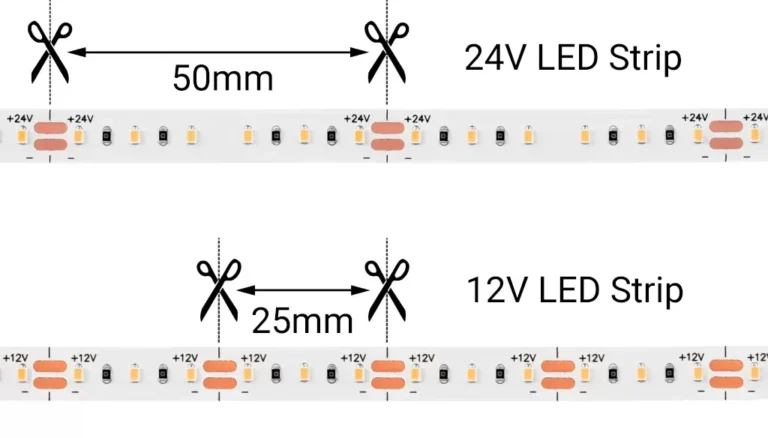введение
На сайте Светодиодная лента Установка, выбор напряжения часто недооценивается, но он напрямую влияет на согласованность яркости, энергоэффективность и долгосрочные затраты на техническое обслуживание. Многие инсталляторы сталкивались с разочаровывающими ситуациями: светодиодные полосы затемняются в середине пробега, или частое питание, необходимое после установки. В большинстве случаев эти проблемы вызваны выбором неправильной системы напряжения: 12В, 24В или 48В. Для более глубокого сравнения двух наиболее распространенных напряжений см. нашу полную инструкцию: Светодиодные ленты 12В и 24 В – как выбрать.
Выбор правильного напряжения светодиодной ленты имеет решающее значение для предотвращения падения напряжения — потери напряжения, которое происходит, когда электрический ток проходит через полосу, вызывая неравномерную яркость и потраченную энергию. Системы с более высоким напряжением снижают ток при той же выходной мощности, что минимизирует падение напряжения и нарастание тепла, особенно в длительных циклах.
Например, светодиодные ленты 12 В обеспечивают высокую гибкость и идеально подходят для краткосрочных проектов DIY, светодиодные ленты 24 В обеспечивают большой баланс между производительностью и стоимостью при сережных лентах средней длины, а светодиодные ленты 48 В превосходны в установках на дальние расстояния и в крупномасштабных инженерных проектах. В этом руководстве будут разбиты основы напряжения, различия в производительности и сценарии с наилучшими использованием, что поможет вам с уверенностью выбрать правильное напряжение светодиодной ленты для любого проекта освещения.

Понимание напряжения светодиодной ленты
При выборе напряжения светодиодной ленты важно понимать взаимосвязь между напряжением и максимальной длиной ленты светодиодных лент.
Для светодиодных лент с постоянным напряжением, для подачи той же мощности требуется меньший ток, что помогает уменьшить падение напряжения и поддерживать постоянную яркость по всей длине полосы.
Типичные характеристики:
12 В светодиодные полосы: Поддерживайте стабильную яркость до 5 метров (16 футов); за пределами этой длины может произойти заметное затемнение.
24В светодиодные полосы: Обычно поддерживают пробеги около 10 метров (33 фута), при этом некоторые высококачественные варианты достигают до 15 метров.
48 В светодиодные полосы: Может пробегать 15–20 метров (50–65 футов) и более; в сочетании с системой светодиодных лент с постоянным током длина 30–40 метров (100–130 футов) или более достижима.
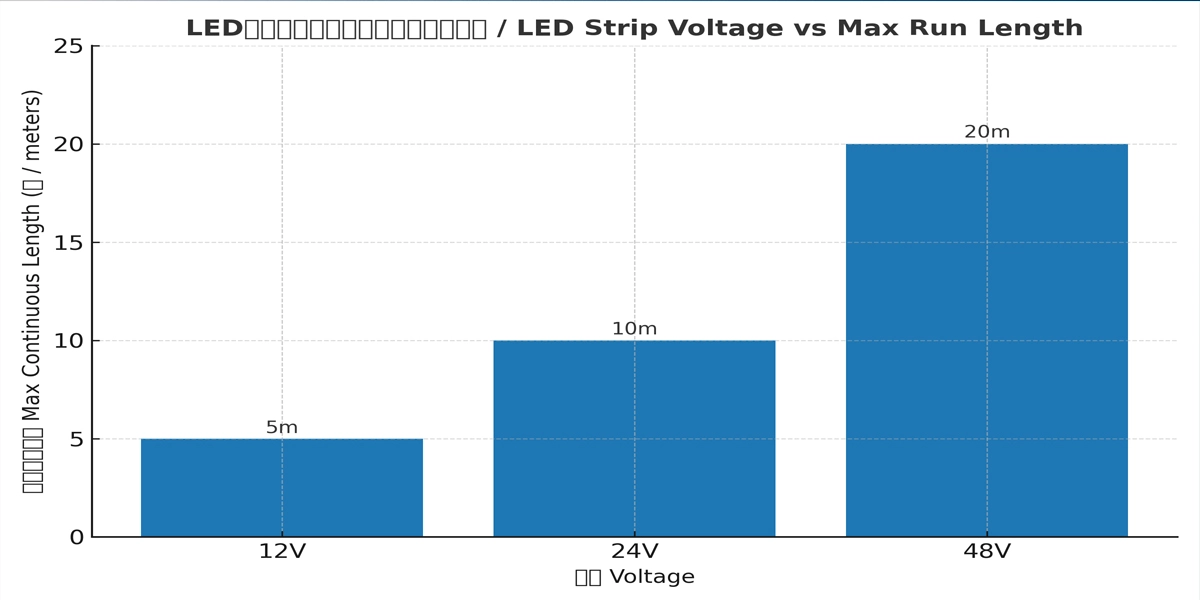
Еще одна ключевая концепция — постоянное напряжение и постоянный ток:
Светодиодные ленты постоянного напряжения (такие как 12В, 24В, 48В) используют источник питания с фиксированным напряжением и просты в установке и управлении, но более склонны к падению напряжения на дальние расстояния.
Светодиодные полосы постоянного тока обеспечивают стабильный ток, обеспечивая равномерную яркость и цветовую температуру на увеличенной длине, что идеально подходит для крупномасштабных проектов, требующих максимальной производительности и согласованности.
Понимая эти основы, вы можете выбрать правильное напряжение светодиодной ленты, которое уравновешивает длину установки, согласованность яркости, сложность проводки и общую стоимость, обеспечивая как эффективность, так и качество визуального качества.
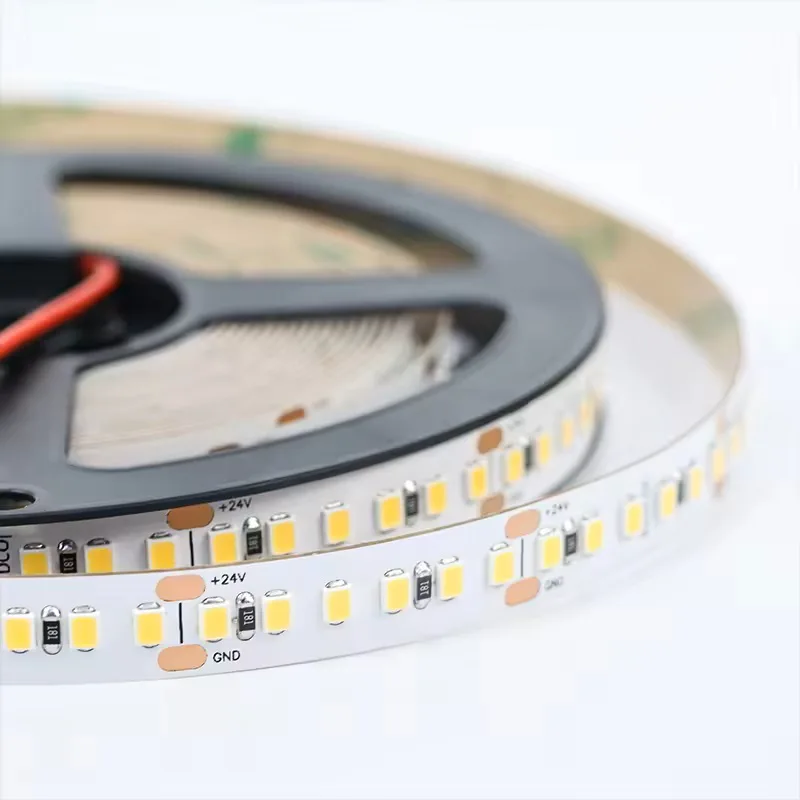
Свет ленты СИД SMD2835
Основная модель: FQX08T120C
Светодиод Количество на метр Опция: 60/72/120/128/140
Вариант ширины печатной платы: 6 мм/8 мм/10 мм
Вариант цвета: 2700K/3000K/4000K/5000K/6500K
Вариант CRI: 80/90
Входное напряжение: DC12V/DC24V
Мощность на метр: 6W/8W/9.6W/12W/14.4W/19.2W
Эффективность: 100-200 люмен/ватт
Вариант класса IP: IP20/IP54/IP65/IP67/IP68
Гарантия: 5 лет
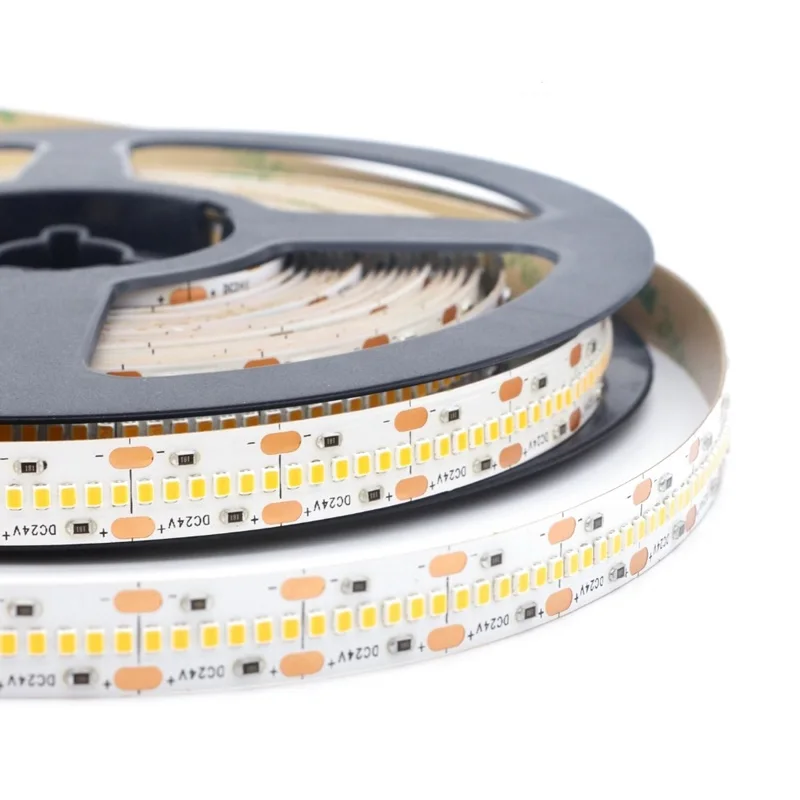
Свет полосы СИД SMD2216
Основная модель: FWX10T240C
Светодиод Количество на метр Опция: 120/180/240/300/420
Вариант ширины печатной платы: 5 мм/10 мм
Вариант цвета: 2700K/3000K/4000K/5000K/6500K
Вариант CRI: 80/90
Входное напряжение: DC12V/DC24V
Мощность на метр: 9.6W/10W/14.4W/19.2W/20W/24W
Вариант класса IP: IP20/IP54/IP65/IP67/IP68
Гарантия: 5 лет

Постоянный ток долго бежать светодиодные ленты света
Основная модель: FQX10T120D
Метр в рулоне Опция: 10м/20м/30м/50м
Вариант ширины печатной платы: 10 мм/12 мм
Вариант цвета: 2700K/3000K/4000K/5000K/6500K
Вариант CRI: 80/90
Входное напряжение: DC24V/DC36V/DC48V
Мощность на метр: 4.2W/7.2W/8.5W/12W
Вариант класса IP: IP20/IP54/IP65/IP67/IP68
Гарантия: 5 лет
Когда выбрать 12В, 24В или 48В светодиодные ленты
12 В светодиодные ленты
Светодиодные ленты 12 В работают при более низком напряжении, что означает более высокий ток для той же мощности. Эта конструкция позволяет сократить интервалы резки — обычно 25–50 мм, что делает их идеальными для детальных установок, таких как полки дисплеев, мебельные акценты и автомобильные интерьеры.
Однако, поскольку низковольтные системы более подвержены падению напряжения, работа более 5 м без впрыска энергии может привести к заметной потере яркости. Это связано с сопротивлением в проводниках и проводке полосы, что является более выраженным ограничением в 12 В, чем в системах 24 В или 48 В.

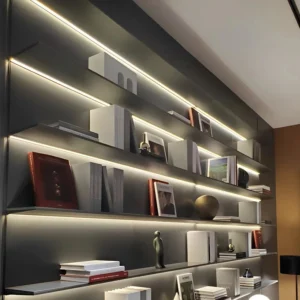
Лучше всего для:
Короткие пробега до 5 м без видимой потери яркости
Декоративное и акцентное освещение в мебели, полках и небольших помещениях
Автомобильные, морские, автофургоны и низковольтные системы с солнечной энергией
Плюсы:
- Низкая первоначальная стоимость и широко доступные драйверы и диммеры
- Гибкая установка благодаря коротким интервалам резки
- Сильная совместимость с 12В-системами на базе батареи
Конс:
- Заметное падение напряжения на более длительных циклах без впрыска энергии
- Более низкая эффективность по сравнению с системами с более высоким напряжением для больших расстояний
24 В светодиодные ленты
Светодиодные ленты 24 В удвоят напряжение 12 В, что сокращает ток пополам при той же выходной мощности. Это уменьшает нагрев и падение напряжения, что позволяет работать до 10 м без потери яркости.
Более высокое напряжение означает более высокую эффективность и более стабильное освещение для таких приложений, как освещение отеля, розничные полки и офисное освещение. В то время как интервалы резания обычно длиннее (50–100 мм), ограничивая сверхточный обрезку, общий баланс между эффективностью, стоимостью и стабильностью яркости делает 24В предпочтительным выбором для многих коммерческих проектов.
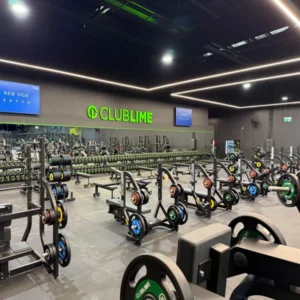
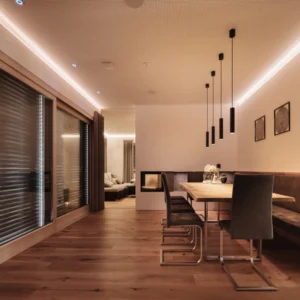
Лучше всего для:
Установки средней длины около 10 м
Коммерческое освещение в отелях, офисах и витринах на полках
Пространства, требующие постоянной яркости и плавного затемнения
Плюсы:
- Меньший ток снижает нагрев и повышает эффективность при средних работах
- Сбалансированное соотношение затрат и производительности для большинства коммерческих приложений
- Широкая совместимость с драйверами профессионального уровня и контроллерами DMX/DALI
Конс:
- Большие интервалы резки снижают гибкость при монтаже с узкой подгонкой
- Немного выше первоначальная стоимость, чем 12В системы
Светодиодные ленты 48 В
Светодиодные ленты 48 В обеспечивают самый низкий ток для той же мощности, что значительно минимизирует падение напряжения даже на расстояниях 15–20 м и более. Это обеспечивает равномерную яркость на крупномасштабных установках, таких как фасады зданий, длинные бухты или архитектурные элементы на открытом воздухе без частых точек впрыска энергии.
Снижение сложности проводки и меньшее количество источников питания снижают затраты на установку и техническое обслуживание. Однако самые длинные интервалы резания (100–200 мм) ограничивают использование в конструкциях, требующих точного монтажа. Кроме того, совместимые драйверы и системы затемнения менее распространены по сравнению с вариантами 12 В и 24 В.
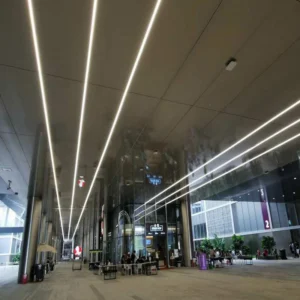
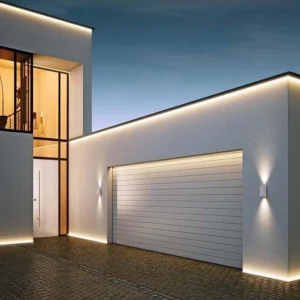
Лучше всего для:
15–20 м и более дальних установок
Архитектурное освещение фасада, потолочные бухты и крупные проекты на открытом воздухе
Коммерческие или инженерные проекты, направленные на минимизацию электропроводки и питания
Плюсы:
- Самый низкий ток среди трех напряжений, обеспечивающий максимально стабильную яркость
- Высокая энергоэффективность на дальние расстояния
- Требуется меньшее количество источников питания, что снижает сложность проводки и техническое обслуживание
Конс:
- Ограниченная доступность совместимых драйверов и контроллеров по сравнению с 12V/24V
- Длинные интервалы резки сокращают возможности настройки в ограниченном пространстве
Руководство по выбору напряжения светодиодной ленты
| Напряжение | лучше для | Максимальная длина прогона | Типичный интервал резки | Общий диапазон мощности (Вт/м) | Плюсы | Cons |
| 12V | Короткие пробеги ≤ 5 м; декоративное освещение; автомобильное, морское, RV, солнечные системы | ~5 метр | 25–50 мм | 4,8–14,4 Вт/м | Низкая стоимость; короткие интервалы резки, высокая совместимость с 12-вольтовыми системами | Более высокое падение напряжения при длительных пробегах; низкая эффективность при больших расстояниях |
| 24V | Средний пробег ~10 м, гостиницы, офисы, торговые полки, стабильные затемнения | ~10 м | 50–100 мм | 7.2–19.2 Вт/м | Низкий ток снижает тепло, хороший баланс экономии и производительности; совместим с профессиональными драйверами | Более длительные интервалы резки, чем 12В, немного выше стоимость |
| 48V | Длинные пробежки 15–20 м+, архитектурные фасады, крупные проекты на открытом воздухе | 15–20+ м | 100–200 мм | 10–20 Вт/м | Самый низкий ток, минимальное падение напряжения; наибольшая эффективность при длительных циклах; требуется меньшее количество источников питания | Ограниченные возможности драйвера/контроллера; самые длительные интервалы резки |
* Максимальная длина пробега основана на стандартной установке без дополнительной мощности.
Ошибки, которых следует избегать при выборе напряжения светодиодной ленты
Неправильный выбор напряжения светодиодной ленты может привести к потере яркости, перегреву или дорогостоящей доработке. Вот самые распространенные ошибки, которых следует избегать:
Использование полос 12 В для длительных пробежек без впрыска мощности
Светодиодные ленты 12В идеально подходят для коротких прогонов (≤5 м). Использование их на больших расстояниях без добавления дополнительных силовых подаваний приведет к падению видимой яркости.
Резка полосы в неправильном положении
Будь то 12В, 24В или 48В, всегда режут на обозначенные медные колодки. Резка в другом месте может повредить цепь и сделать полосу непригодной для использования.
Соответствие неправильному напряжению питания
Никогда не подключайте полоску 12 В к источнику питания 24 В или 48 В (или наоборот). Это может мгновенно сжечь светодиоды.
Узнайте больше о том, почему несоответствие напряжения может повредить ваши светодиоды в нашем подробном руководстве: Подключение светодиодных лент 12 В в блок питания 24 В.
Игнорирование расчетов падения напряжения
Для пробега более 5 м (12 В), 10 м (24 В) или 20 м (48 В) заранее вычислить падение напряжения и планировать впрыскивание мощности или системы с более высоким напряжением.
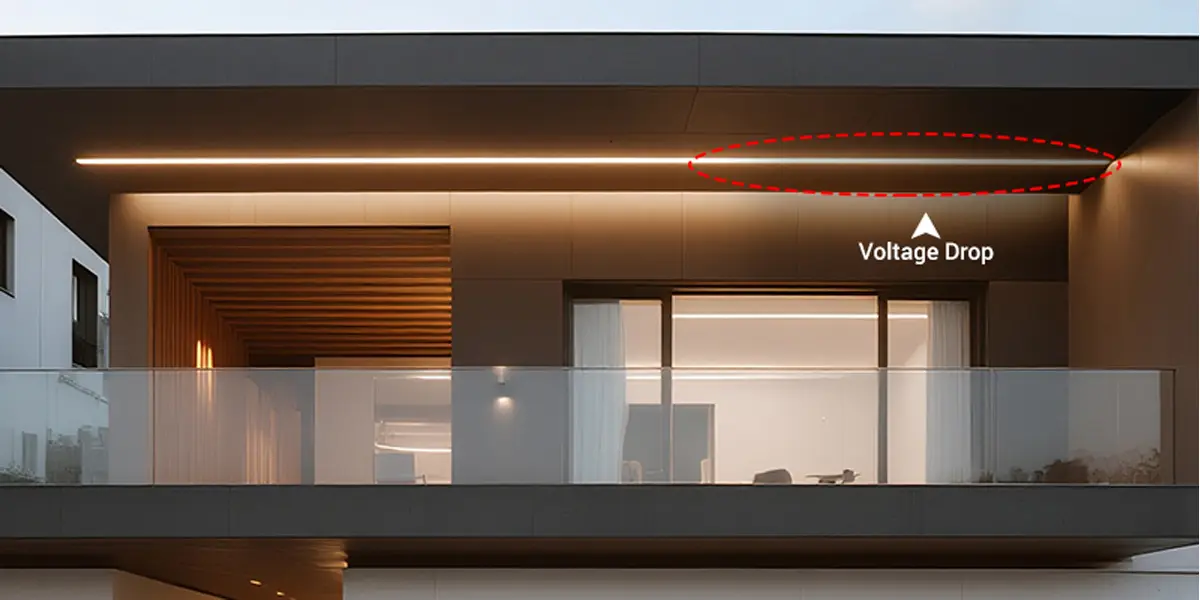
Перегрузка блока питания
Всегда выбирайте драйвер с мощностью как минимум на 20–30%, чем общая мощность ваших светодиодных лент.
FAQ – выбор напряжения светодиодной ленты
нет , йо- Подача более высокого напряжения, чем полоса, рассчитана на то, что увеличится избыточный привод, что приведет к перегреву, повреждению или мгновенному сбою. Всегда сопоставьте напряжение полосы с напряжением питания.
Для большинства установок на открытом воздухе предпочтительны светодиодные ленты 24 В или 48 В, поскольку они обеспечивают более длительные прогоны с меньшим падением напряжения, что важно для крупномасштабного архитектурного или фасадного освещения.
12В: до 5 м без впрыска мощности
24В: до 10 м без впрыска мощности
48В: до 15–20 м без впрыска мощности
Для более длительных прохождений требуются дополнительные подачи питания или параллельная проводка.
Светодиодные ленты 12 В лучше всего подходят для автомобильных, морских и автофургонных систем, потому что они напрямую совместимы с 12-вольтовыми аккумуляторными системами. Если вы планируете подключить несколько светодиодных лент 12 В к одному источнику питания, ознакомьтесь с нашим пошаговым руководством: Можно ли подключить несколько светодиодных лент 12 В к одному источнику питания?
Не обязательно. Яркость зависит от типа светодиода, плотности (светодиоды на метр) и мощности. Напряжение в основном влияет на длину пробега и эффективность.
Заключение
Правильный выбор напряжения светодиодной ленты влияет не только на результаты установки, но и на согласованность яркости, энергоэффективность и затраты на техническое обслуживание.
Короткие пробега и точное освещение: 12 В для гибкой резки и совместимости с маловольтными батарейными системами.
Средние запуски и коммерческие помещения: выбирайте 24 В для сбалансированного сочетания производительности и стоимости.
Длинные пробежки и масштабные проекты: 48 В, чтобы свести к минимуму падение напряжения и упростить проводку.
Для достижения наилучшего результата, прежде чем принять решение, рассмотрите длину пробега, требования к резке, расположение и безопасность, что обеспечивает оптимальный баланс между производительностью, стоимостью и обслуживанием.
Чтобы оценить энергопотребление и эффективность вашего проекта, ознакомьтесь с нашим полным руководством: Сколько электричества потребляет светодиодная лента?

